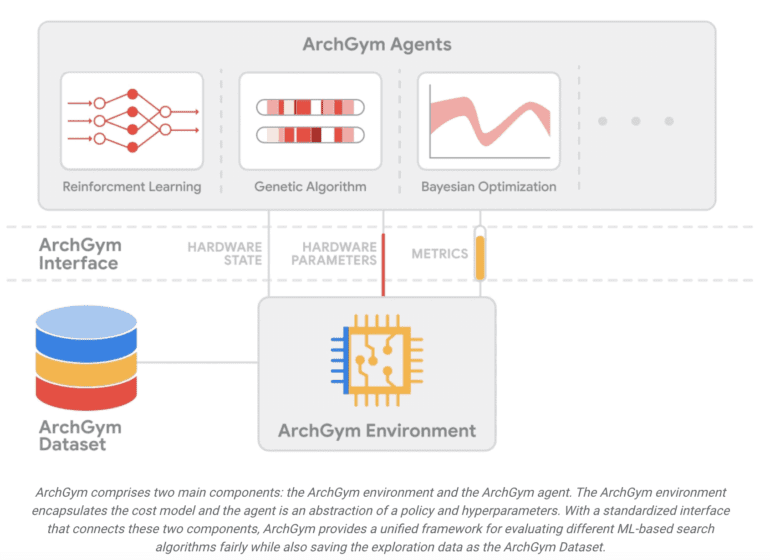TL;DR:
- Google AI’s ArchGym integrates machine learning and architecture simulators, transforming computer architecture research.
- ArchGym addresses challenges in ML-based architecture studies, offering a systematic method for determining optimal algorithms and hyperparameters.
- It balances precision, efficiency, and economy in computer architecture exploration by providing a unified framework for evaluating ML-based search algorithms.
- ArchGym overcomes commercial licensing restrictions, enhancing the frequency of simulator usage for data collection and design exploration.
- The platform enables effective visualization of exploration output, empowering researchers to gain insights into the design space.
- ArchGym comprises two components: the ArchGym environment and the ArchGym agent, which work together to compute computational costs and guide the ML algorithm during the search process.
- The standardized interface of ArchGym ensures seamless communication between the agent and the environment, leveraging hardware status, parameters, and metrics.
- Empirical studies show that ArchGym achieves hardware performance comparable to other ML methods, fostering collaboration and providing robust baselines for computer architecture research.
Main AI News:
In the realm of computer architecture research, simulators and tools have long played a crucial role in shaping the design of computer systems. However, the incorporation of machine learning (ML) techniques into this field has posed significant challenges. Addressing this issue head-on, Google AI introduces ArchGym, an innovative open-source gymnasium that seamlessly integrates ML algorithms with architecture simulators. This breakthrough integration marks a pivotal moment in computer architecture research, fostering innovation and providing a unified framework to overcome obstacles.
Studying architecture with machine learning has faced a critical hurdle—the absence of a systematic method to determine the optimal ML algorithm and hyperparameters for specific computer architecture problems. Google AI’s ArchGym aims to rectify this by offering a comprehensive solution that revolutionizes the way researchers approach these challenges. By bringing together ML algorithms and architecture simulators, ArchGym empowers researchers to unlock new insights and push the boundaries of computer architecture research.
A pressing challenge faced by computer architecture simulators is the delicate balance between precision, efficiency, and economy during exploration. Different models utilized within simulators can yield vastly different performance estimates, such as cycle-accurate or ML-based proxy models. This variance introduces complexities in accurately evaluating architectural progress. ArchGym, with its integrated ML algorithms, provides a standardized and unified framework to consistently evaluate ML-based search algorithms, bridging the gap between simulation and machine learning.
Furthermore, commercial licensing restrictions often limit the frequency of simulator usage for data collection, impeding the optimization of design exploration. This limitation necessitates careful consideration of trade-offs between performance and sample efficiency when selecting the optimization algorithm. ArchGym recognizes this challenge and offers a solution by providing an open-source environment that allows researchers to overcome licensing barriers, enhancing the freedom to explore and innovate.
The evolving landscape of ML algorithms presents its own set of challenges. ML algorithms heavily rely on data, and gaining insights into the design space requires effective visualization of exploration output, such as datasets. ArchGym acknowledges this need and provides researchers with robust visualization capabilities, enabling them to effectively analyze and understand the intricate relationships between architectural parameters and performance.
ArchGym comprises two pivotal components: the ArchGym environment and the ArchGym agent. The ArchGym environment encapsulates the architecture cost model and desired workload(s), enabling the computation of computational costs based on specific architectural parameters. On the other hand, the ArchGym agent incorporates hyperparameters and policies that guide the ML algorithm during the search process. These hyperparameters and policies profoundly influence the optimization results, determining the agent’s ability to optimize the goal over time.
The true power of ArchGym lies in its ability to establish a reliable communication line between the agent and the environment. By integrating these two components through a standardized interface, ArchGym enables seamless interaction and information exchange. This interface relies on three primary signals: hardware status, parameters, and metrics. These signals empower the agent to monitor the hardware’s health, make informed recommendations, and maximize hardware efficiency while catering to customer-specified rewards.
Empirical studies conducted by Google researchers have shown that ArchGym consistently achieves hardware performance comparable to other ML methods. It demonstrates its efficacy across a wide range of optimization targets and design space exploration scenarios. By fostering collaboration among researchers, ArchGym serves as open-source software that encourages the exchange of ideas and facilitates the evaluation of ML techniques. Furthermore, it establishes robust baselines for computer architecture research, enabling future advancements to build upon a solid foundation.
Conclusion:
The integration of machine learning and architecture simulators through ArchGym has far-reaching implications for the market. It enables researchers to overcome challenges in computer architecture studies and offers a systematic approach for optimal algorithm selection. ArchGym’s unified framework balances precision, efficiency, and economy, driving innovation in the field. By providing an open-source environment and addressing licensing restrictions, it promotes collaboration and fosters exploration. The visualization capabilities of ArchGym empower researchers to gain valuable insights into the design space. Overall, ArchGym sets a solid foundation for future advancements and establishes itself as a pivotal tool in computer architecture research, propelling the market forward.

